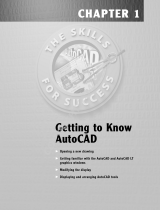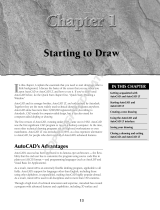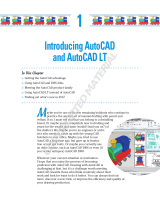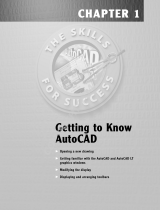Page is loading ...

1
AutoCAD
®
2013 Preview Guide
With powerful tools for design aggregation, AutoCAD® 2013 software helps connect and streamline your
design and documentation workflows. Import and aggregate models from almost any format, and
quickly create detailed design layouts and drawing views that automatically update when the source
model changes. Save time with an enhanced and more effortless user interface and a customizable
command line display. Synchronize your drawings with Autodesk® 360 technology to access your
designs from almost anywhere. You can find and install hundreds of different Autodesk screened
AutoCAD companion apps from a single destination, extending the power of your software more easily
than ever before.

2
Table of Contents
Table of Contents .................................................................................................................. 2
User Interaction .................................................................................................................... 3
Welcome Screen ................................................................................................................................. 3
AutoCAD Help ..................................................................................................................................... 4
Command Line Enhancements ............................................................................................................ 5
In-Canvas Property Preview ................................................................................................................ 8
Array Enhancements ........................................................................................................................... 9
Layout and Model Viewports ............................................................................................................ 11
Quick View Drawings ........................................................................................................................ 12
Hatch Editor ...................................................................................................................................... 13
Raster Images ................................................................................................................................... 13
External References .......................................................................................................................... 13
Snap Behavior ................................................................................................................................... 14
Explore ................................................................................................................................ 14
Point Cloud Support .......................................................................................................................... 14
PressPull ........................................................................................................................................... 19
Surface Curve Extraction ................................................................................................................... 20
Import Inventor Files ........................................................................................................................ 21
Document ........................................................................................................................... 21
Model Documentation ...................................................................................................................... 21
Text and Leaders ............................................................................................................................... 31
Wipeout ............................................................................................................................................ 32
Polylines ........................................................................................................................................... 32
Offset Preview .................................................................................................................................. 33
Connect ............................................................................................................................... 33
Autodesk 360 Connectivity ............................................................................................................... 33
Stay Connected ................................................................................................................................. 39
Content Explorer ............................................................................................................................... 39
Language Packs ................................................................................................................................. 40
Drawing File Format .......................................................................................................................... 40
Customization ..................................................................................................................... 41
Double-click Actions.......................................................................................................................... 41
Autodesk Exchange Apps .................................................................................................................. 41

3
User Interaction
Welcome Screen
A Welcome Screen is automatically displayed when you launch AutoCAD 2013. It provides easy access to
drawings, learning tools, and online content.
In the Work panel of the Welcome Screen, you can create new drawings as well as open your existing
drawings and sample files. A Recent Files list provides easy access to your most recently used drawings.
The Learn panel offers an overview of functionality new to AutoCAD 2013, provides links to videos to
help you get started in AutoCAD 2013, and includes additional online learning resources.
In the Extend panel, you can easily download apps from Autodesk® Exchange Apps and connect to
Autodesk 360 and AutoCAD social media resources, including Facebook and Twitter.
You can choose not to display the Welcome screen during startup using a control in the lower left
corner. It will still be accessible from the Help menu.

4
AutoCAD Help
The online Help system for AutoCAD has been significantly restructured to provide faster, search-based
results. You can access the AutoCAD Help system from the Help icon on the InfoCenter. The Online help
window is displayed by default.
If you are offline or if you have disabled online content from the System tab of the Options dialog box,
Online Help will not be displayed.
Instead, Offline Help is made available as an optional download.

5
Command Line Enhancements
The command line interface has been modernized in AutoCAD 2013 to include color, transparency, and
increased flexibility for displaying history and accessing recent commands. You can dock the command
line at the top or bottom of the AutoCAD window or let it float to maximize the drawing area.
The undocked command line is displayed in a single row that floats above the AutoCAD window. It
includes a semi-transparent prompt history, enabling you to display up to 50 lines of history without
affecting the drawing area. A new tool on the command line provides easy access to the number of lines
of prompt history, as well as Autocomplete, Transparency, and Options controls.
You can press the F2 key or the flyout at the right end of the floating command line to display additional
lines of command history.

6
Pressing Ctrl F2 displays the history window.
When the command line is undocked, you can snap it to the edge of the AutoCAD window or a docked
palette by moving it near the edge. When you resize or move the AutoCAD window or docked palette,
the command line moves accordingly to maintain its position relative to the edge. If you undock the
adjacent palette, the command line automatically snaps to the next palette or AutoCAD window.
You can dock the command line at the top or bottom of the AutoCAD window by clicking and holding on
the dragging area at the left end of the command line while you move it. If you want to place the

7
command line on the edge of a frame without snapping, simply press the Ctrl key while moving it.
Whether the command line is floating or docked, a command icon helps identify the command line and
indicates when AutoCAD is awaiting a command. You can click on the command icon to quickly view and
launch the most recently used commands.
When a command is active, the command name is always displayed on the command line. Clickable
options, displayed in blue, offer easy access to options within the active command.
Additional enhancements to the command line interface in AutoCAD 2013 provide more consistent
behavior for line breaking when responding to different types of input: Enter, space bar, and pick point.
The command line window (including the F2 window) now supports only monospaced fonts. You can set
the command line font from the Display tab of the Options dialog box .
New interface elements provide more flexibility and control over the color of the command line. You can
access them using the Colors tool on the Display tab of the Options dialog box.

8
In-Canvas Property Preview
In AutoCAD 2013 you can dynamically preview changes to object properties before applying them. For
example, if you select objects and then use the Properties palette to change the color, the selected
objects dynamically change color as you pass the cursor over each color in the list or within the Select
Color dialog box.
Object transparency is also dynamically applied as you change the transparency.

9
You can control the property preview behavior using the Property Preview option on the Selection tab
of the Options dialog.
Array Enhancements
Enhanced array functionality in AutoCAD 2013 helps you create objects in a pattern faster and easier
than ever before.
After you select objects for a rectangular array, they are immediately displayed in a three-row-by-four-
column grid. When creating a polar array, the selected objects are displayed immediately after you
specify a center point, in a full circular pattern of six. After selecting objects and a path for a path array,
the objects are immediately displayed evenly along the entire length of the path. For each type of
array—rectangular, polar, and path—multifunctional grips on the array objects enable you to
dynamically edit relevant properties. You can use the Ctrl key to cycle through grips with multiple
options. In addition to using multifunctional grips, you can modify array values in the contextual ribbon
tabs as well as at the command line.

10
Path arrays offer more flexibility and control in AutoCAD 2013 when using the measure method. It is
easier to specify the orientation of the arrayed objects relative to the path using the Tangent Direction
option during creation.
The item count toggle allows the count to be based on the spacing and curve length (to fill the path), or
you can explicitly control the count. As you increase or decrease spacing the item, the number of items
automatically decreases or increases to fit on the specified path. Similarly, when the path length
changes, the number of items automatically increases or decreases to fill the path.

11
When the item count toggle is off, an additional grip at the end of the array provides dynamic editing of
the item count and total item spacing to array along a portion of the path curve.
Layout and Model Viewports
The viewports panel on the ribbon is renamed to be specific to Model Viewports or Layout Viewports.
Model Viewports are accessible from the View ribbon tab and are relevant when creating viewports in
model space. Standard model space viewport configurations are easily accessible from a drop-down
menu.

12
Layout Viewports are accessible from the Layout ribbon tab and are relevant when creating viewports
on a layout.
Quick View Drawings
Bold texts and colorful borders in the Quick View Drawings thumbnails help emphasize the current
active view.

13
Hatch Editor
AutoCAD 2013 is enhanced to make editing multiple hatch objects faster and easier. The contextual
Hatch Editor ribbon tab is automatically displayed even when you select more than one hatch object.
Similarly, when using the command line version of the hatch editor (-HATCHEDIT), you can now select
multiple hatch objects for simultaneous editing.
Raster Images
The bitonal resampling algorithm has been updated to improve the display quality of a wide range of
supported images.
External References
External Reference functionality has been updated. Now you can edit the Saved Path directly in the
External References palette and the Found path is displayed as read-only.

14
The right-click menu includes some additional updates. In the dialog boxes, the default type is set to
Relative Path unless the relative path is not available—for example, if the drawing has not yet been
saved or the host drawing and external file are located in different disk partitions.
Snap Behavior
A new Legacy option in the Snap tool offers increased flexibility when snapping to grid points. If Snap
Legacy mode is set to yes, the cursor snaps based on the snap spacing, regardless of whether you’re in a
command, specifying points, or selecting objects.
When Legacy is set to no, the cursor snaps based on the snap spacing only when specifying points within
a command. The snap spacing is ignored when no command is active and when selecting objects within
a command. .
Explore
Point Cloud Support
Point cloud functionality is significantly enhanced in AutoCAD 2013. Point cloud tools are available on
the new Point Cloud toolbar and in the Point Cloud panel on the Insert ribbon tab.

15
You can attach and manage point cloud files similar to working with xrefs, images, and other externally
referenced files.
The Attach Point Cloud dialog box has been updated to provide a preview image and detailed
information about the selected point cloud.

16
Selecting an attached point cloud displays a bounding box around the data to help you visualize its
position in 3D space and relative to other 3D objects. In addition to displaying a bounding box, selecting
a point cloud automatically displays the Point Cloud ribbon tab with easy access to relevant tools.

17
You can adjust the point cloud density and, if intensity data is included with the point cloud, you can use
the analysis tools to view point intensity with different color schemes including gray scale or spectrum.
New clipping tools enable you to create and modify clipping boundaries for the selected point cloud.
Additional options enable you to specify whether the bounding box is displayed and provide easy access
to the External References manager.
The Properties palette is updated to include new point cloud properties such as intensity and clipping.

18
Point cloud indexing is significantly enhanced in AutoCAD 2013 to provide a smoother and more
efficient workflow when working with raw scan files. You can index scan files from major industrial
scanner companies, including Leica and Topcon in addition to Faro.
The new Create Point Cloud File dialog box provides an intuitive and flexible interface to select and
index raw point scan files. You can select multiple files to batch index and even merge them into a single
point cloud file. When creating PCG files, you can specify various Index settings, including RGB, Intensity,
normals, and custom attributes.

19
When you save from AutoCAD 2013 to an older version DWG
TM
file, a message alerts you that the
attached PCG file will be re-indexed and degraded to be compatible with the previous version of the
drawing file format. The new file is renamed to a corresponding incremental file name.
PressPull
The PressPull tool, available on the Modeling panel of the Home ribbon tab, is enhanced in AutoCAD
2013 to be more flexible and context-sensitive.
You can use the new Multiple option or the Shift key to press or pull multiple objects in a single
operation.

20
Additionally, you are no longer limited to clicking inside a bounded area. Now you can select 2D and 3D
curves as well.
When selecting a face with the Presspull tool, the default behavior extrudes the face straight out. If you
press the Ctrl key when you select a planar face, you can offset it as it extrudes to follow the taper
angles of adjacent sides.
Surface Curve Extraction
The new Extract Isolines tool, available from the Curves panel of the Surface ribbon tab, enables you to
easily extract isoline curves from an existing surface or face of a solid.
Options within the Extract Isolines tool enable you to change the direction of the isolines, select a chain
of isolines, and draw a spline on the curved surface by specifying spline points.
/






